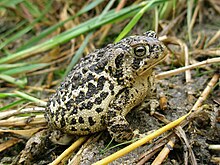Wyoming toad
| Wyoming toad | |
|---|---|
 |
|
| Scientific classification | |
| Kingdom: | Animalia |
| Phylum: | Chordata |
| Class: | Amphibia |
| Order: | Anura |
| Family: | Bufonidae |
| Genus: | Anaxyrus |
| Species: | A. baxteri |
| Binomial name | |
|
Anaxyrus baxteri (Porter, 1968) |
|
 |
|
| Synonyms | |
|
Bufo hemiophrys baxteri Porter, 1968 |
|
Bufo hemiophrys baxteri Porter, 1968
Bufo baxteri Porter, 1968
The Wyoming toad or Baxter's toad (Anaxyrus baxteri, formerly Bufo baxteri) is an extremely rare amphibian that exists only in captivity and within Mortenson Lake National Wildlife Refuge in Wyoming in the United States. The Wyoming toad was listed as an endangered species in 1984, and listed as extinct in the wild since 1991. Before the sharp declines occurred, this toad was classified as a subspecies of the Canadian toad.
The Wyoming toad, common up until the 1950s, became significantly fewer in number in the late 1970s, especially between the years of 1975 to 1978. Two years later, in 1980, experts estimated that there were approximately 25 individuals remaining in the wild. Before this sharp decline in population, Wyoming toads were commonly found in the floodplains, ponds, shallow lakes, and seepage pools within the Laramie Basin located in Albany County, Wyoming. Researchers had noted that the species was found abundantly in the region since 1952. However, starting in 1975, Baxter & Stromberg noticed that the population of the Wyoming toad had decreased significantly. Their extreme rarity, documented between 1976 and 1978 revealed no remaining wild populations.
The Wyoming toad is dark brown, gray or green color with small dark markings on underside. Also it carries small rounded blotches warts on its dorsal surface as well as blurry light lines. The male toads have a dark throat. The individual toads can be identified by the variation in their skin colors and wart patterns. The toads can grow up to 5.6 cm (2.2 inches) in length and females grow slightly larger than males. It also has sensitive skin that has low adaptability. Due to the fact that it has sensitive skin, it is easily infected with chytrid fungus (strong threat to the Wyoming toads). Also, the toad cannot handle the rapid climate change, and cannot adapt to different amounts of water irrigation or diverged irrigation. The toad is mainly active at night and has very poor eyesight. It only relies on the movement of the prey to hunt.
The Wyoming toad frequents floodplains and the short grass edges of ponds, creeks, and lakes. They frequently use abandoned pocket gopher and ground squirrel burrows as hibernacula.
...
Wikipedia

